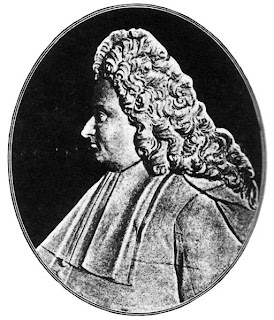Valsalva
Antonio Maria Valsalva was an important Italian physician that was born in Imola in 1666. He was a contemporary of Newton, Bach and Molière and, following the traditions of his time, was educated in humanities, mathematics, and natural sciences.
After his studies of the liberal arts, he studied Medicine and Philosophy at the University of Bologna, where he was a disciple of Marcello Malpighi, the founder of microscopic anatomy. Malpighi deeply respected Valsalva, who was his favorite student. And Valsalva was a great admirer of Malpighi.
 |
| Portrait of Valsalva (Wikimedia Commons) |
He was considered a very skilled anatomist and pathologist, a fine physician and an excellent surgeon, working in the hospitals of Bologna for 25 years. As a surgeon he anticipated the importance of nephrectomy, and worked in ophthalmology, rhinology, and vascular and tumor surgery. He was particularly successful in dealing with aneurisms and invented many useful surgical instruments.
His main interest was the ear. In 1704 he published his extraordinary book about the human ear, De Aure Humana Tractatus, that became a standard on the subject for over a century, describing his anatomical, physiological, and pathological observations of the ear. Even the small muscles of the ear were described in detail. He was responsible for the division of the ear into its external, middle, and internal parts, and described an original method of inflating the middle ear, which is still used today and is appropriately named Valsalva's manoeuver. He also described the tympanic antrum and an area of the nasal septum that is frequently involved in nasal bleeding and is known as locus Valsalvae (Valsalva’s area).
 |
| Valsalva's medical contributiona bublished by Morgagni (Wikimedia Commons) |
Valsalva gave the name of Bartolomeo Eustachius to the auditory tuba (Eustachian tube) and described its function. It seems that this was the first time that an anatomist honored another one by giving his name to an anatomical structure. He also showed the connection between the mastoid cells and the tympanic cavity.
Another of his important contributions was his perception that motor paralyses occur on the opposite side of the cerebral lesion, both in cerebral vascular accidents and in cases of cranial trauma. He also made important contributions to Morgagni’s great work De sedibus et causis morborum.
Valsalva also has a place in the history of psychiatry: he was among the first to insist on humanitarian treatment for the insane, preceding Vincenzo Chiarugi (1759-1820) and Philippe Pinel (1745-1826). He always considered madness as analogous to organic disease.
In 1721, during a consultation with Morgagni in Venice, he suffered a temporary dyslalia. This was an early sign of the violent cerebral vascular accident that caused his death in 1723.
Besides being an excellent physician, Valsalva also became noted for his high scientific integrity, and was a very kind man. According to Morgagni, “. . . there is nobody of those times who goes ahead of him, very few who are his equals.”



Comments
Post a Comment